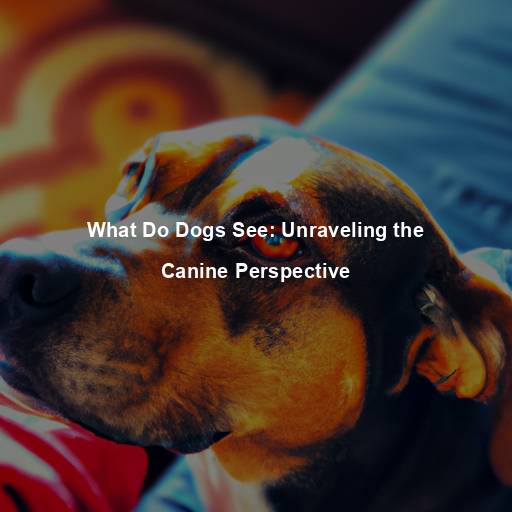Do Dogs Know When You Are Sad?
Last Updated on November 23, 2023 by Evan
Contents [hide]
- 1
- 2 Understanding Canine Emotions
- 3 Decoding Canine Body Language
- 4 The Science Behind Dogs’ Empathy
- 5 The Bond Between Humans and Dogs
- 6 The Evolutionary Perspective
- 7 Individual Variations in Canine Empathy
- 8 The Power of Emotional Support Animals
- 9 The Importance of Mutual Care and Understanding
- 10 The Healing Power of the Human-Dog Bond
- 11 Embracing the Magic of Canine Companionship
- 12 FAQs on Do Dogs Know When You Are Sad:
Dogs have long been hailed as man’s best friend, known for their unwavering loyalty, unconditional love, and ability to understand and respond to human emotions. Many pet owners have experienced moments when their canine companions seem to sense their sadness and offer comfort in their own unique ways. But do dogs truly understand when we are sad? Can they empathize with us and provide solace during difficult times?
Understanding Canine Emotions
Before we dive into the specific question of whether dogs can detect human sadness, it is essential to understand that dogs do experience a range of emotions themselves. Studies have shown that dogs possess complex emotional lives, similar to humans. They can experience joy, fear, anger, and even jealousy. Their ability to perceive and interpret human emotions is a testament to their emotional intelligence.
Decoding Canine Body Language
Understanding the intricacies of the way that dogs respond to human emotions is an engaging and enigmatic journey. By delving into the realm of non-verbal communication, we uncover a captivating tapestry of facial expressions, body postures, and tail wagging that comprise their unique language. Dogs possess an innate ability to detect the faintest traces of sadness in humans, ever watchful of the subtle cues that hint at our emotional state. Through astute observation, they glean meaning from the arch of an eyebrow or the delicate path of tears, deftly deciphering our distress.
Facial Expressions
Incredible findings have emerged from recent research, shedding light on the astonishing skills of man’s best friend. A publication in the esteemed journal “Behavioural Processes” has revealed that our loyal companions, dogs, possess an uncanny ability to decipher the intricate language of our facial expressions. The study indicates that dogs can accurately distinguish between the spectrum of emotions, with a particular affinity for individuals displaying sorrow. These results hint at the existence of an innate understanding within dogs, a deep connection that transcends species boundaries and perplexes even the most astute scientists.
Body Language
Have you ever noticed how dogs seem to have a sixth sense when it comes to reading our emotions? It’s not just about the wagging tail or the soulful eyes – these furry companions pay attention to our every move. From the way we carry ourselves to the smallest shift in our posture, dogs are like emotional detectives, always on the lookout for signs of distress or happiness. Their keen observation skills allow them to pick up on the tiniest cues, giving them a unique insight into our wellbeing.
Vocal Cues
Dogs, those incredible creatures that have been by our side for centuries, seem to possess an uncanny ability to understand our emotions, even when we don’t utter a word. While we communicate with them through non-verbal signals, it turns out that the tone of our voice can also influence how they perceive our inner state. Imagine, when we feel sad, our voice might subtly transform, becoming softer or more subdued, and these subtle changes don’t go unnoticed by our furry companions. Their keen sense of hearing allows them to pick up on these variations, and in response, they offer solace in the form of comforting gestures; leaning against us, gently nudging us with their snouts.
The Science Behind Dogs’ Empathy
The enigmatic mystery of whether dogs possess a profound grasp of human sorrow transcends mere anecdotal tales. Countless minds of science have embarked on a quest to unravel this beguiling phenomenon. Employing a kaleidoscope of captivating approaches, these studies have delved deep into the intricate fabric of canine empathy, painstakingly deciphering their uncanny aptitude to embrace and react to the complex tapestry of human emotions.
The “Still-Face” Experiment
A fascinating study conducted at the University of Vienna delved into the complex dynamics between dogs and their owners. Researchers introduced a modified version of the “still-face” paradigm that left participants puzzled. Dog owners were given the perplexing task of either maintaining a neutral expression or revealing their feelings of sadness while interacting with their furry companions. The results were astonishing, as the dogs exhibited bursts of unexpected behavior.
Neuroscientific Evidence
Neuroscientific studies have provided further insights into the mechanisms behind dogs’ empathy. Functional magnetic resonance imaging (fMRI) scans have revealed that dogs’ brains exhibit activity in regions associated with emotion processing when exposed to human emotional stimuli. This suggests that dogs not only recognize human emotions but also experience emotional responses themselves. The activation of these brain regions closely mirrors the neural patterns observed in humans, further strengthening the argument for dogs’ emotional intelligence.
The Bond Between Humans and Dogs
Throughout the annals of time, an extraordinary connection has blossomed between Homo sapiens and our four-legged counterparts, dogs. In a constant dance of evolution, canines have seamlessly integrated themselves into the tapestry of our lives, navigating the complexities of our human society and intuitively grasping the tangled web of our emotions. This harmonious interplay has woven an unbreakable thread between us, transforming these mesmerizing creatures into more than just faithful sidekicks but also indispensable reservoirs of solace and understanding.
The ability of dogs to detect and respond to human sadness serves as a testament to the strength of this bond. Whether it be offering a sympathetic paw or simply providing a comforting presence, dogs have an uncanny ability to uplift our spirits and provide solace during our darkest moments. Their unwavering loyalty and intuitive understanding of our emotions make them invaluable allies in our journey through life.
The Evolutionary Perspective
To truly comprehend why dogs may possess an innate ability to detect human sadness, we must consider their evolutionary history. Dogs are descendants of wolves, which are highly social animals known for their intricate pack dynamics. In the wild, wolves rely on strong emotional bonds within their packs for survival. These bonds allow them to effectively coordinate their actions, communicate, and care for one another.
As dogs evolved from wolves and became domesticated, they retained many of their social and emotional instincts. This includes their sensitivity to human emotions. Dogs have learned to adapt to our social cues and have developed a remarkable ability to understand and respond to our emotional needs. This evolutionary perspective provides insight into why dogs may have an inherent understanding of human sadness and a natural inclination to provide comfort and support.
Individual Variations in Canine Empathy
It’s no secret that dogs have a special way of connecting with their human friends, with an uncanny ability to understand and empathize with their emotions. However, it’s important to keep in mind that not all dogs are cut from the same cloth when it comes to empathy. Just like humans, our furry companions showcase a wide range of empathetic abilities, with some dogs showing a natural knack for tuning in to their human counterparts and others requiring a little more guidance.
When it comes to a dog’s ability to sense and react to their human companion’s sadness, numerous variables come into play. Factors such as breed, temperament, and personal encounters can all have an impact on their sensitivity levels. While certain dogs may possess a remarkable knack for tuning into their owners’ emotions, others may show empathy in their own peculiar ways. It’s essential to bear in mind that every dog has its own individual empathetic inclinations, making them all the more fascinating and perplexing creatures to study.
The Power of Emotional Support Animals
The extraordinary gift of dogs to sense and empathize with human melancholy has propelled them into the limelight as sought-after emotional comrades. These furry guardians offer solace, camaraderie, and a much-needed anchor for people wrestling with the profound depths of mental anguish – be it the gripping tendrils of anxiety, the haunting shadows of depression, or the indelible scars of post-traumatic stress disorder (PTSD). With hearts as infinite as their loyalty, these canine caretakers have become beacons of hope, navigating the turbulent seas of our emotional landscape with uncanny finesse and unwavering devotion.
The presence of an ESA can have a profound positive impact on an individual’s well-being. Dogs, in particular, have been shown to alleviate symptoms of anxiety and depression, reduce stress levels, and provide a sense of calm and security. Their unwavering companionship and ability to sense and respond to their owners’ emotional needs make them invaluable allies in promoting emotional well-being.
The Importance of Mutual Care and Understanding
While dogs may possess an innate understanding of human sadness, it is equally important for humans to reciprocate this care and understanding. As pet owners, we have a responsibility to provide our canine companions with a nurturing and supportive environment. This includes being attuned to their emotional needs, providing them with proper care, and establishing a strong bond built on trust and love.
Understanding that dogs have their own emotional range and unique ways of expressing themselves is crucial. By learning to interpret their body language, vocalizations, and individual quirks, we can better understand their emotional states and respond appropriately. This mutual care and understanding strengthen the human-dog bond and contribute to a harmonious and fulfilling relationship.
The Healing Power of the Human-Dog Bond
Have you ever wondered if dogs possess the profound intuition to sense our emotional distress? The intriguing and thought-provoking question of whether our furry friends can truly discern when we are feeling down takes us on a captivating journey, delving into the remarkable healing power of the human-dog bond. Beyond the confines of language, this connection reaches into the depths of our souls, connecting us on an emotional level that knows no boundaries. It is during our most bewildering and despairing moments that dogs display their extraordinary capacity to offer solace, strength, and unwavering affection, reminding us of the boundless depths of their love.
The therapeutic benefits of the human-dog bond extend beyond detecting human sadness. Dogs have been utilized in various therapeutic settings, including hospitals, nursing homes, and rehabilitation centers. Their presence has been shown to improve patients’ well-being, reduce stress, and even aid in physical and cognitive recovery.
In a world where stress, loneliness, and emotional struggles are prevalent, the companionship of a dog can make a world of difference. Their unwavering loyalty, non-judgmental nature, and ability to understand and respond to our emotions bring immense joy, comfort, and solace.
Embracing the Magic of Canine Companionship
After much contemplation and deep analysis, it becomes abundantly clear that dogs possess an astonishing awareness of human emotions, particularly when it comes to our sorrows. Their unyielding observation prowess, coupled with an innate emotional intelligence, allows them to fathom our sadness even before we fully grasp it ourselves. In a seemingly magical exchange, dogs release the bonding hormone, oxytocin, as a compassionate response, offering solace, friendship, and an unwavering, enigmatic presence during our most delicate and fragile instances.
As pet owners, it is our responsibility to cherish and nurture the bond we share with our canine companions. By fostering a mutual understanding, providing love and care, and recognizing their unique emotional needs, we can create a harmonious and fulfilling relationship that benefits both humans and dogs alike.
So, the next time you find yourself feeling sad or overwhelmed, take solace in the fact that your loyal furry friend is there to offer a listening ear, a sympathetic gaze, and a paw to lean on. Embrace the magic of canine companionship and cherish the profound connection that exists between humans and their beloved dogs.
FAQs on Do Dogs Know When You Are Sad:
Do dogs have the ability to sense human emotions?
There is no denying the remarkable talents possessed by our canine companions. From their extraordinary olfactory abilities to their acute hearing and astute powers of observation, dogs have an uncanny knack for picking up on subtle cues, including our very own emotions. While their understanding of emotions may differ from our human comprehension, they possess an innate ability to sense shifts in our behavior, interpret our body language, and even discern the slightest changes in our facial expressions. Truly perplexing and bursting with astuteness, dogs continuously fascinate us with their perceptive nature.
Can dogs detect sadness?
In a world full of wonder and intrigue, there exists a fascinating phenomenon – the profound connection between dogs and humans. These extraordinary beings possess an uncanny ability to decipher the intricate language of emotions. With their keen senses attuned to the subtleties of voice, body, and energy, dogs hold the power to perceive the ever-shifting waves of melancholy that wash over their beloved owners. As tears well up, sighs escape, and shoulders droop, these intuitive creatures stand by, ready to interpret this enigmatic display as a sign that something is amiss.
How do dogs react when their owners are sad?
When dogs sense that their owners are sad, they often display empathetic behavior. Dogs may approach the sad person with gentle nudges, comforting touches, or offering their presence and companionship. They might try to cheer up their owner by wagging their tail, bringing a toy, or simply by sitting close and providing comfort through physical contact. Some dogs may even become more subdued or cautious when they perceive their owner’s sadness, adapting their behavior to provide support.
Why do dogs react to sadness?
The enigmatic connection between humans and dogs and their uncanny ability to empathize with our emotions is a topic that continues to bewilder researchers. It is intriguing to consider the possible evolutionary underpinnings behind this phenomenon, as dogs have undoubtedly coexisted with humans throughout the ages, forming an intricately woven tapestry of mutual support and understanding. The mesmerizing idea that dogs may possess an innate instinct to decipher our emotional state, stemming from a deep-rooted survival mechanism, adds another layer of fascination to this intriguing subject. Moreover, the social nature of dogs, coupled with their instinctual drive to foster positive interactions, suggests that their tendency to provide solace and seek solace when they detect distress in their human counterparts is an intricate dance of interconnectedness and symbiosis.
Can dogs sense sadness in other people?
Yes, dogs can often sense sadness in people other than their owners. While they may have a stronger connection and bond with their primary caregivers, dogs are generally perceptive to emotional cues from any individual they are familiar with. Whether it’s a family member, friend, or even a stranger, dogs can pick up on changes in a person’s behavior or demeanor that indicate sadness. They might exhibit similar empathetic behaviors and provide comfort to anyone they perceive as in need.
Is it beneficial for dogs to comfort sad humans?
Yes, providing comfort to sad humans can be beneficial for both the dogs and the humans involved. Comforting a person in distress can contribute to strengthening the bond between the dog and their owner or improving the dog’s overall social skills. Additionally, the act of providing emotional support can also be soothing and fulfilling for the dog, as they naturally enjoy helping their loved ones. It is important to note that each dog is unique, and their response to sadness may vary based on their individual personality and training.







